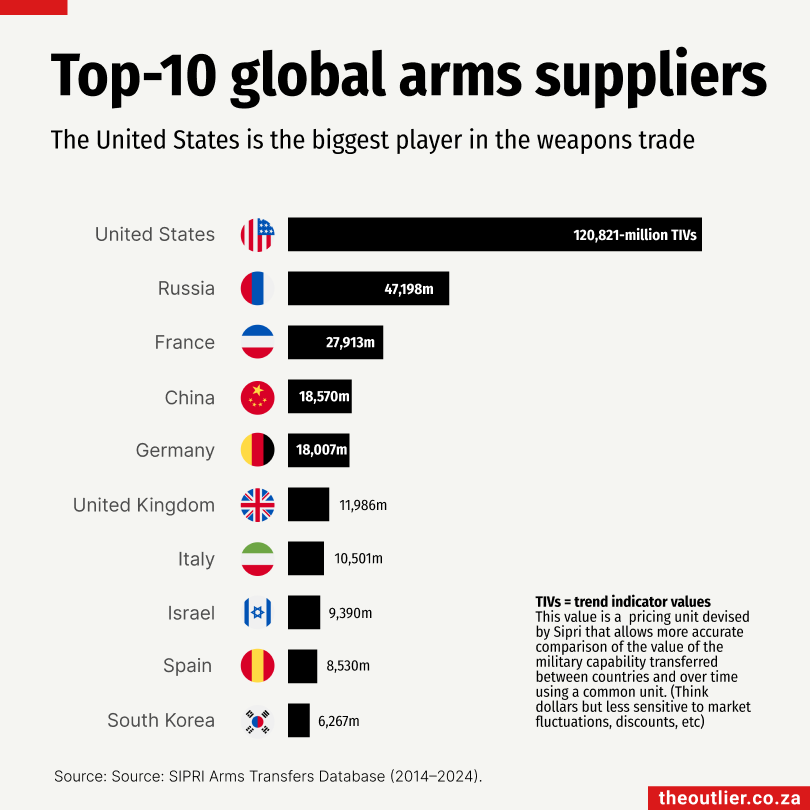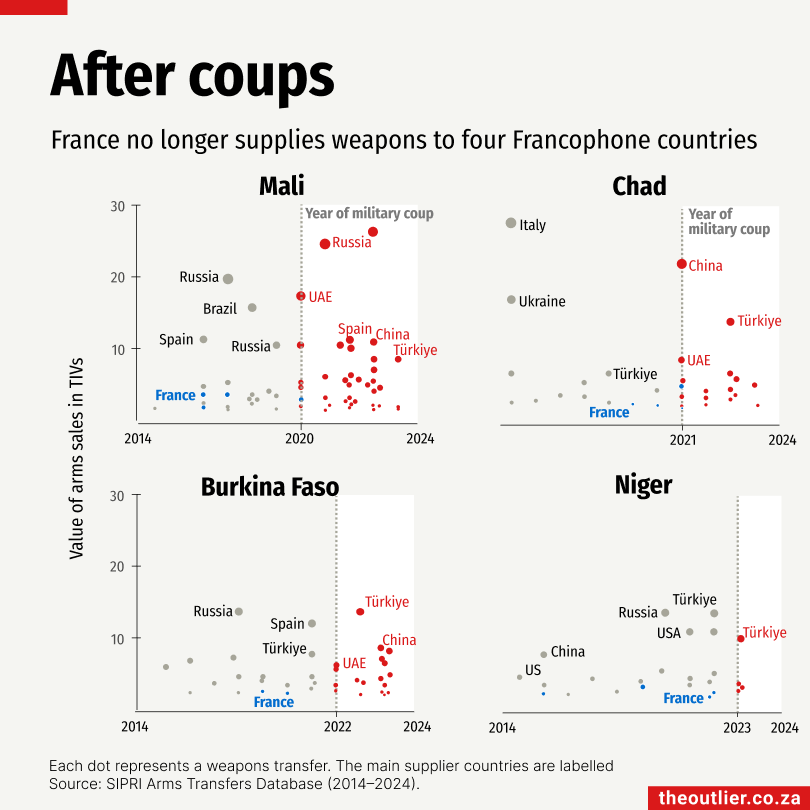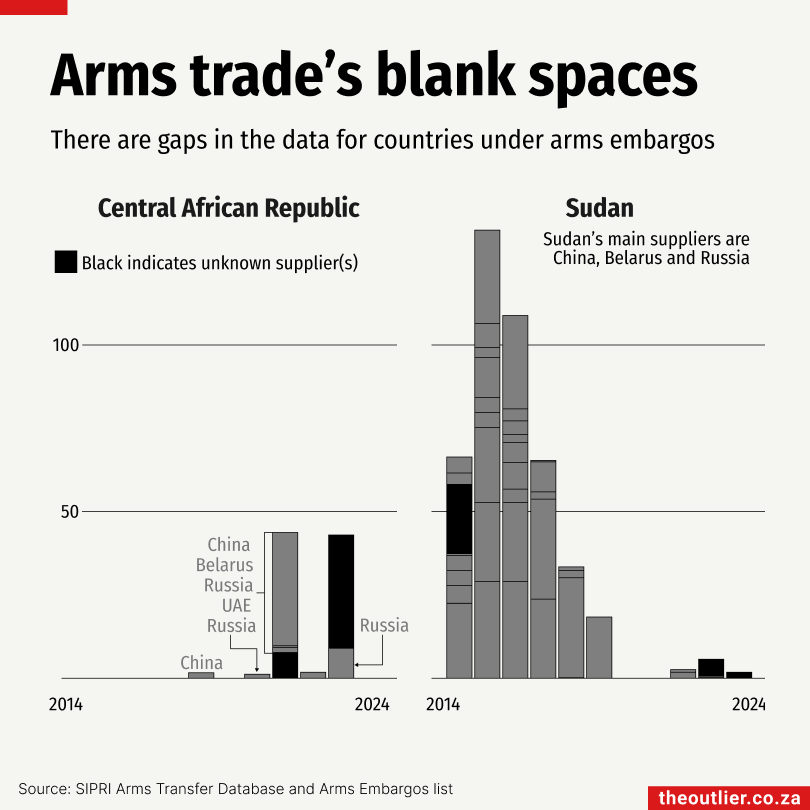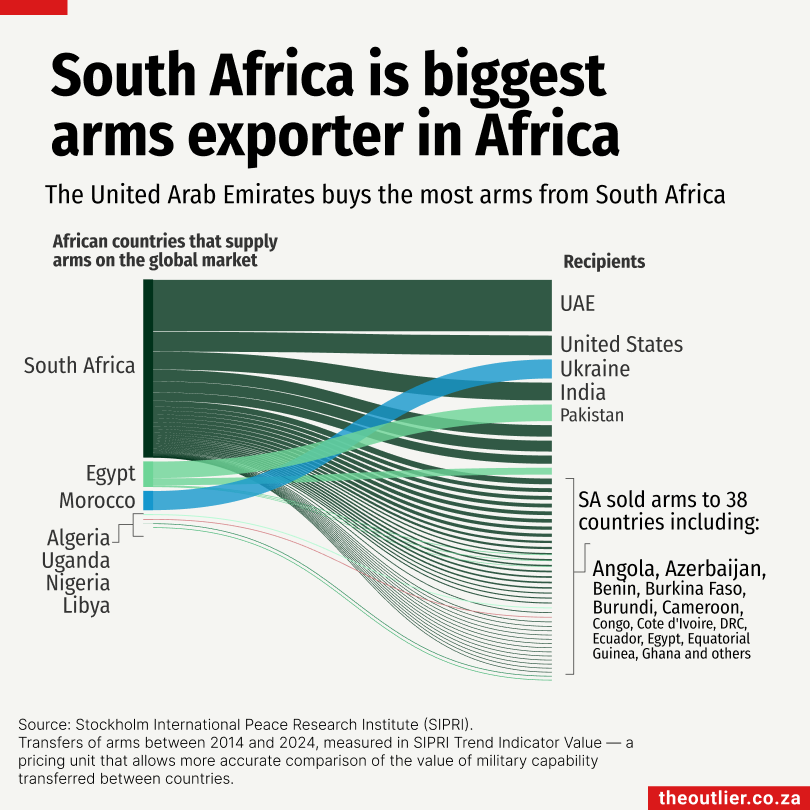📝 By Ro Manoim and Laura Grant
South Africa’s involvement in the Democratic Republic of Congo, albeit as part of a peacekeeping mission, got us wondering who supplies African countries with arms.
The United States is by some margin the biggest global arms supplier, followed by Russia, France, China and Germany, according to data compiled by non-partisan research organisation Stockholm International Peace Research Institute (Sipri). Sipri has devised a pricing unit that allows more accurate comparison of the value of the military capability transferred between countries and over time. It’s called Trend Indicator Value (TIV) and all the charts below use this value.
Over a 10-year period between 2014 and 2024, the United States supplied the world with two-and-a-half times more weapons than Russia, and four times more than France, based on TIV units.

In Africa, Russia is the top supplier of arms, followed by France then the United States and China.
There are only seven African countries that export arms globally on Sipri’s list. South Africa sells the most, although it doesn’t feature in the the global top-20 (it’s ranked 23). Also, it is not a major supplier of arms to African countries.
Egypt, Algeria and Morocco account for most of the arms bought by African countries. Between 2014 and 2024, Egypt, Africa’s top weapons buyer, was also the fourth-biggest weapons buyer in the world (surpassed only by Saudi Arabia, India and Qatar) and Algeria ranks 11th.

The African arms market is shaped by historical relationships and current politics. Most African countries that buy arms, get them from Russia, France, the United States and China, the global top-four.
Russia, which supplies arms to 23 African countries, exports the most arms by value to this continent. It has deep roots with many of these countries dating back to independence struggles and Cold War-era conflicts.
Although the United States is the world’s largest arms exporter, its exports to Africa remain relatively small in value, but it supplies arms to 30 countries, a few more than Russia.
The strong military relationship between France and some African countries is founded on colonial ties, but with increasing anti-French sentiment in former colonies, France is losing some of its market share.
China, despite transferring less advanced military technology than its competitors, has the widest reach — supplying arms to 36 African countries.
Changing suppliers can be financially costly for African states due to existing expertise in specific weapons systems and the logistics of maintenance.
Coups
The tight military ties between France and many of its former colonies in Africa have broken down after the numerous military coups in francophone African countries in the past five years. Not only have French troops been expelled (or withdrawn), but some of these countries are no longer buying arms from France, but rather trading with countries such as Türkiye, the United Arab Emirates, China, and other African countries.

Who sells arms to countries in conflict?
Someone does. But the data is murky. The United Nations’ arms embargo on Sudan and the Central African Republic either affects the arms sold to that country or (and this is more likely) affects whether these transactions are documented. The UN found evidence of arms transferred to areas under embargo like Darfur (Sudan).
In the last few years there have been armed conflicts in Burkina Faso, the Central African Republic, the Democratic Republic of Congo (DRC), Ethiopia, Mali, Mozambique, Niger, Nigeria, Somalia, South Sudan and Sudan.
For some countries with active conflict, the United Nations issues arms embargoes as a way to mitigate the violence. During these conflicts, arms are often available despite official channels being more heavily monitored. Blanks in the data and vague information like ‘unknown supplier’ represent these periods of violent conflict where arms may be available but aren’t being formally traded.
The arms embargo rules change regularly. For some states like the DRC, Somalia, and South Sudan, UN embargoes are in place, but only for specific actors or categories of weapons. The EU also has its own arms embargoes in place, including an active embargo on Zimbabwe.

South Africa
South Africa is Africa’s biggest arms exporter. It’s one of only seven African countries that sell arms, according to Sipri’s arms trade list. Egypt, Morocco, Algeria, Uganda, Nigeria and Libya are the others. South Africa’s biggest market is the United Arab Emirates.

SA’s speciality is making military vehicles, known as armoured or combat vehicles.
Paramount makes for example the Mbombe-4 ‘armoured’ vehicle, 20 of which were sold to the DRC in 2023 and 90 of which were sold to India between 2022-2024. In the 10 years between 2014 and 2024 it did sell missiles to the UAE, Malaysia and Algeria, naval weapons to Angola and aircraft to the United States.

South Africa has policies designed to ensure a more ‘ethical’ arms trade by providing South African officials to ‘inspect’ the exported stock to ensure it isn’t going to questionable third parties. However, economic pressure may undermine these policies. South African weapons have been singled out by civil society groups for their role in human rights violations such as in Yemen.
Note: The main measurement used in this newsletter is the Sipri Trend Indicator Value (TIV). This value is a pricing unit devised by Sipri that allows more accurate comparison of the value of the military capability transferred between countries and over time using a common unit. (Think dollars but less sensitive to market fluctuations, discounts, etc.) It is based on the known cost of production of each weapon and the amount transferred. More information on this value, described as a sort of “military capability price index” can be found here.
Most of the data used unless otherwise specified is 2014-2024. This is because we wanted to convey general trends, and military transfers often look like one huge order of ships in 2018 and then nothing for the next five years, so to minimise outliers and skewing, we selected a broader range of time. All dates refer to year of delivery.